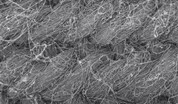
The Phase 2b clinical trial with RRx-001 (nibrozetone) against chemotherapy and radiation-induced severe oral mucositis (SOM), called KEVLARx, takes its name, obviously, from the bulletproof polymer called Kevlar® that was invented at DuPont™. The hope is that the anti-inflammatory and antioxidant properties of RRx-001 (nibrozetone) in KEVLARx will, like Kevlar®, ‘proof’ patients against treatment-related harms. Here are some interesting facts about DuPont’s™ Kevlar ®:
- Kevlar ® or Poly-paraphenylene terephthalamide (K29), a giant invention, was synthesized by a determined – and diminutive – DuPont™ chemist, Stephanie Kwolek, who stood 4’11”. Kwolek is the only woman in the history of DuPont to ever win the company’s Lavoisier Medal for outstanding technical achievement. Read our previous blog entitled, Spotlight on Stephanie Kwolek (1923-2014), Chemist and Inventor Extraordinaire, here.
- Pound for pound, Kevlar ®, a plastic, is over 10 times stronger than regular steel and twice as strong as ordinary nylon.
- Its strength comes from inter-chain bonds, which are like microscopic woven fibers, as shown below.

- In addition to bulletproof vests and knifeproof body armor, the high-strength, highly durable Kevlar ® fibers, which absorb high-velocity impacts, and form a protective barrier against slashes, cuts, punctures, and ballistics, like a medieval suit of armor, only much, much lighter, are used for dozens and dozens of other applications – spacesuits, airplanes, optic cables, boats, brake pads, bowstrings, underground mining equipment, gloves, car tires, baseball bats, cellphones, sneakers, notebook computers, sailboats, and mine-resistant military vehicles, to name a few.
- It is inherently heat-resistant up to 850 degrees Fahrenheit, and, unlike most plastics, Kevlar ® fibers won’t melt or burn.
